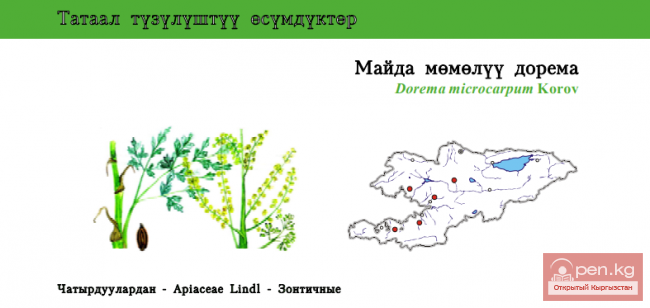
Alai Centaury Status: VU. Endemic species....

Aulie-Ata Stemmacantha Centaury Status: EN. A very rare species, critically endangered....

html Korshinsky’s Meadow Saxifrage Status: EN. A rare endemic species found in small numbers and...

html Lamyropappus schakaptaricus Status: VU. A rare representative of a monotypic genus....

Acantholimon compactum Status: VU. A very rare narrowly endemic species....

Schennikov’s Otostegia Status: VU. A rare endemic species, endemic to Kyrgyzstan with a disjunct...

Dwarf Ammopiptanth Status: EN. A rare species with a disjunctive range. One of two known...

Wrapped Alpine Saw-wort Status: VU. Rare species. Found in Kyrgyzstan at the edge of its range....

Glacial Pastinacopsis Status: EN. A rare endemic species of a monotypic genus in the Northern Tien...

Golden Trichanthemis Centaury Status: VU. A rare narrowly endemic species of the Alai Ridge, an...

Kaufmannia Semenova Status: VU. Endemic, rare species....

Korzhinski’s Pear Status: VU. One of three species growing in the territory of the Kyrgyz...

Kashgarian Barberry Status: VU. Rare species....

Regel’s Eminium Status: VU. A rare endemic species of the Western Tien Shan....

Pskem Onion Status: EN. A very rare species with a shrinking range in the Western Tien Shan....

Paradoxical Honeysuckle Status: Category CR B2ab(iii). A relict endemic species with a disjunctive...

Related Tulip Status: VU. Endemic species of the northern Pamir-Alai. The species is at risk of...

Quadrifolious Tulip Status: VU. Endemic to the Inner Tien Shan....

Rhodiola litwinowii Status: LC. A mosaic-distributed species, intensively used in agriculture....

Tianschaniella umbellifera Status: VU. A significantly declining narrowly endemic species of...

Short-winged Bladder-senna Status: VU. One of three very rarely occurring species of this genus in...

Edelweiss-like Pyrethrum Status: VU. Endemic species....

Eremurus zoae Status: VU. A narrowly endemic species of the Kyrgyz Range....

Kolpakovski’s Tulip Status: VU. An endemic of the Northern Tien Shan with a decreasing population....

Anomalous Alajja (Erianthera anomala) Status: VU. Endemic to the mountains of Central Asia. A rare...

Wolly-fruited Kosopoljanskia Status: EN. Endemic. One of the two species that are sub-endemic to...

Korolkov’s Sage Status: VU. A rare narrow endemic species. A highly decorative plant....

Hairy Flowering Plant Aulie-Ata Status: EN. A representative of a monotypic section, a narrowly...

Kashgarian Bean Caper Status: VU. Rare, little-studied endemic species....

Petunnikov’s Almond Status: VU. One of 40 species growing from the Mediterranean to Central Asia....

Nathaliella alaica Status: CR B2ab(iii). A rare, endemic species of a monotypic genus of Himalayan...

Kostychev’s Pascueflower Status: VU. A narrowly endemic and very beautiful plant, deserving...

Sclerotiaria pentaceros Status: CR B2ab(iii). Endemic to a monotypic genus....

Vvedensky’s Sage Status: VU. A very rare narrowly endemic species. An ornamental plant....

Obtusilobous Windflower Status: VU. The westernmost boundary of its range in Kyrgyzstan is located...

Niedzvetzki’s Apple-tree Status: VU. Very rare, endemic, endangered species with a small...

Korolkov’s Tulip, shiny Status: VU. Endemic to Central Asia, primarily found in Uzbekistan and...

Semenov’s Onion Status: VU. Endemic to the Inner Tien Shan....

False Hooked Fumitory Status: VU. Endemic species of the Pamir-Alai....

Olga’s Sorbaria Status: CR B2ab(iii). A rare narrow-endemic species of the Alai Mountain Range....

Dorema microcarpum Status: VU. Rare endemic species....

Broad-stamened Tulip Status: VU. A narrow endemic of the Alai Ridge....

All elements and conditions, as well as phenomena and bodies of nature, can be used in public...